Top News
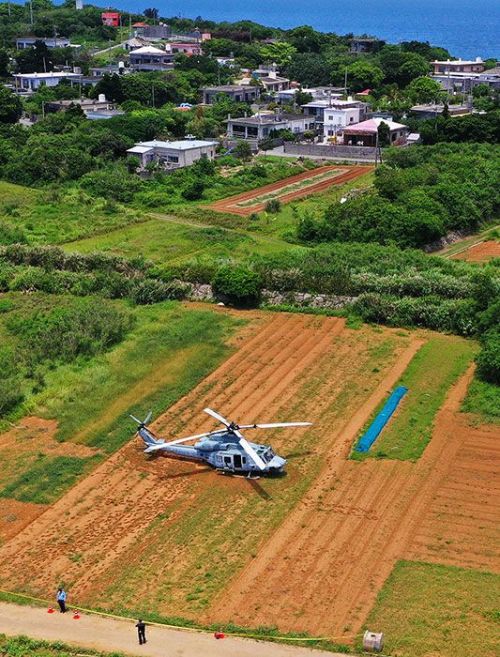
June 4, 2021 Ryukyu Shimpo
The sound of an aircraft covered the island, and immediately after, apprehension enveloped residents. Late at night on June 2, a U.S. military helicopter made an emergency landing on private land on Tsuken Jima in Uruma City, where there are expansive fields. The helicopter landed only 120 meters from homes. One resident said, “I felt panicked.” The U.S. aircraft completely changed the tranquil rural landscape and spread fear among the residents.
Past 10:30 p.m. on June 2, ward head Seitetsu Tamashiro felt that the sound of the helicopter from overhead was louder than usual. A minute later, Tamashiro rushed to the site after a resident informed him that a U.S. military helicopter had made an emergency landing. Tamashiro said, “I was relieved because, happily, there were no major injuries, but I was scared thinking it may have fallen on a home.” After it was reported to the police, a briefing and the like were handled at the site. The next day, June 3, at 4:00 a.m., Tamashito said, “I plan to collaborate with the city and raise my voice in protest.”
The site was cordoned off into two areas with police tape. There were police personnel working near the inner police tape, which was close to the U.S. aircraft that made the emergency landing, and local residents and reporters watched on from next to the outer police tape.
The U.S. soldiers who were the crewmembers on the emergency-landed aircraft sat in the aircraft, waiting for assistance to arrive.
Eisuke Mori, 46, who owns the field across from the landing site, received news of the landing from a friend who came to visit, and said, “Flying overhead is very normal, but …” it was surprising to him “… for something like this to really happen.” He explained that, “If it is this way all the time it will be troublesome for field owners.”
In contrast to the U.S. soldiers, who appeared to be relaxed, sometimes residents visited the site and stared at the helicopter with apprehension.
(English translation by T&CT and Erin Jones)
Go to Japanese
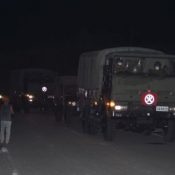
June 3, 2021 Ryukyu Shimpo
The Japan Ground Self-Defense Force (JGSDF) began bringing in munitions such as missiles to their training grounds in Bora Gusukube, Miyakojima June 2. A pair of CH-47 Chinook transport helicopters were seen flying into Miyakojima, and munitions were loaded into vehicles and transported onto the Bora Training Ground. It is thought that this air transport is the beginning of an acceleration of the plan to deploy surface-to-air and surface-to-ship missiles to Miyakojima. Details regarding the amount and type of munitions transported to the island were not officially announced by the JSDF, however it is highly unlikely that the shipment contained surface-to-ship or surface-to-air missiles. According to someone with knowledge of the situation, the JSDF was considering transporting the surface-to-ship and surface-to-air missiles overseas, however it seems they are readjusting their shipping plan.
The two helicopters took off from JASDF Naha Air Base at the same time around noon on June 2. According to a source, the aircraft originated from a JASDF installation in Kyushu, and stopped in Naha for refueling. Just after 1:00 p.m., the Miyako Area Security force informed the city that they would be delivering munitions. Starting at 2:00 p.m. the helicopters landed at the JASDF Miyakojima Sub Base in Ueno Nobaru, Miyakojima. The munitions were loaded onto vehicles, and transported to the Bora Training Ground.
Okinawa governor Denny Tamaki said that the prior information offered to the prefecture and the city was insufficient, commenting that it was “truly regrettable,” and said the evening of the delivery, “It must be strongly indicated that [prior information] is indispensable from a crisis management standpoint.”
Construction began at the Bora Training Ground in 2019, and as of April 2020 two of the three planned ammunition depots have been completed.
The Ministry of Defense (MoD) visited Miyakojima on May 13, and announced that munitions would begin being delivered to the training ground starting May 17. Miyakojima mayor Kazuyuki Zakimi requested that details be made public for the “safety of the citizens,” however the MoD has not responded.
(English translation by T&CT and Sam Grieb)
Go to Japanese
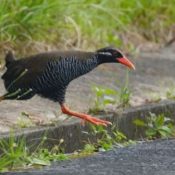
May 30, 2021 Ryukyu Shimpo
(Northern Okinawa) There are frequent occurrences of traffic accidents involving the Yambaru Kuina, a Natural Monument of Japan. On May 29, the Okinawa Amami Natural Environment Office announced that 11 such traffic accidents have been confirmed from January 1 to May 20, with 10 Yambaru Kuina being killed. It said that there may be increased cases of parent birds and chicks running onto the road in May and June, when the parents are raising their young. It also made an appeal for people “to leave plenty of time and take care to drive slowly.”
According to the Office, accident numbers are trending downward in recent years, but increased by two compared to last year (January to May). All of the accidents occurred in Kunigami Village, with many occurring on prefectural roads 2 and 70.
It said that particular caution is needed in the morning and evening and on rainy days, when the birds are most likely to appear on the road.
It asks that if anyone encounters an accident, they should contact a relevant organization. The Ministry of the Environment Yambaru Wildlife Conservation Center (Ufugi Nature Museum) can be reached by telephone at 0980-50-1025. The NPO Dobutsutachi No Byoin Okinawa can be reached by telephone at 090-6857-8917.
(English translation by T&CT and Sandi Aritza)
Go to Japanese
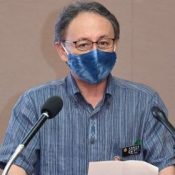
June 4, 2021 Ryukyu Shimpo
On June 3, the Novel Coronavirus Task Force of Okinawa held a meeting and announced that it had been decided on a prefectural level to, as a rule, close prefectural schools for two weeks from June 7-20. On June 4, an online meeting will be held to hear the opinions of local government officials and to ask elementary and junior high schools to also observe the closure. Large commercial facilities with a total floor area of more than 1000 square meters are asked to close on Saturdays and Sundays, beginning on June 5. All events, regardless of scale or location, are asked to postpone or cancel.
Since the nation-wide school closures in the spring of last year, Okinawa is the only prefecture to make the decision to close all prefectural schools. Some towns and cities oppose the measure, so there remains uncertainty as to whether all elementary and junior high schools will also close.
As far as daycare, with the exception of those working in healthcare or other services necessary for daily life, parents and guardians are asked to care for children at home and refrain from sending them to daycare.
Club activities will also be halted with the closure of prefectural schools. Any competitions in Okinawa scheduled during the closure period will be cancelled. Officials are working with the prefectural high school athletic association to come up with a solution for Kyushu tournaments. High school baseball teams that were preparing for preliminaries to be held in other prefectures in advance of this summer’s Koshien will also be subject to the halt in club activities until June 20.
Governor Denny Tamaki held a press conference on the night of June 3. “If we don’t take these steps now, we will face a serious crisis that could bring about the collapse of our healthcare infrastructure,” he explained, asking for understanding and cooperation from residents of Okinawa in reducing their activities by 70%.
Restaurants are asked not to sell alcohol and to reduce their hours of operation. Tamaki indicated plans to make restaurants that cooperate from June 7, including restaurants that have not complied before, eligible for grants for cooperating.
Companies are asked to reduce the number meetings, explanatory meetings, and other business activities by 70%. In addition, the government of Okinawa is calling on businesses to allow workers to take the necessary time of in order to care for children home from school during the closure period. To discourage residents from going out, it is asked that the streetlights in shopping areas be turned off at 8 p.m.
(English translation by T&CT and Ellen Huntley)
Go to Japanese
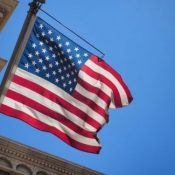
May 31, 2021 Ryukyu Shimpo
By Ryota Nakamura
It was discovered May 30 that when the U.S. sent out $1,400 checks to U.S. citizens as part of their COVID-19 economic stimulus package, some checks were also mistakenly sent out to elderly Okinawans who collect social security from the U.S. Toshiharu Ichikawa, representing the Foreign Pension Support Center, an organization that is an expert in Japanese and American retirement benefits such as social security and pensions, said, “I think the many people who received these were sent them by mistake,” and indicated there is chance that if the checks were cashed, the U.S. government could demand repayment and even reduce retirement benefits, and is calling on those who receive the checks to send them back.
The checks are referred to as “Coronavirus economic impact payments” (EIP), and were sent to U.S. citizens, both domestically and living abroad, and permanent residents in the US as long as their income fell under a certain level determined by the IRS. U.S. military personnel and other people in Okinawa who hold U.S. citizenship were also correctly sent stimulus payments.
Meanwhile, the IRS has listed on their website that “non-resident aliens” do not qualify for the payments, meaning that for the most part Okinawans and other Japanese citizens would not receive the payment. Even if they at one time received social security benefits from the U.S., they still would not qualify. However, it seems that while they were not intended targets for the stimulus payments, the amount of US pension benefits received by some elderly Okinawans qualify as “under the income threshold” for the checks, and as a result many mistakenly received them.
Japanese people who receive U.S. social security include those such as people who were sent to the U.S. to work in a Japanese company’s local office there. The stimulus checks started arriving in Okinawa to those who qualify for U.S. social security starting at the end of May. The IRS prioritized getting the checks out quickly for this round of stimulus payments, and as a result many people were sent checks by mistake. There was no letter of explanation accompanying the checks, however, a letter signed by President Biden followed soon after explaining that they were economic impact payments due to the effect of the COVID-19 pandemic.
(English translation by T&CT and Sam Grieb)
Go to Japanese
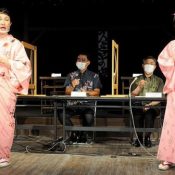
May 28, 2021 Ryukyu Shimpo
The Himeyuri Peace Hall, located in the Himeyuri Alumnae Building in Asato, Naha has reopened after closing due to the coronavirus pandemic. The Okinawa Arts and Culture Promotion Association, a non-profit organization, is taking over operations, with the first phase of the reopening will be staging a play from June 24 through July 17 titled “Shima kuduchi” (written by Keifuku Janamoto, directed by Go Fujii), hosted by ACO Okinawa. They are also planning on putting on other productions starting in August.
The Himeyuri Peace Hall was completed during the renovation of the Himeyuri Alumnae Building, which is owned by the Himeyuri Peace Foundation, developed as a beacon of peace, hosting things such as plays, lecture events, and photo exhibitions. However, due to the effects of the COVID-19 pandemic, usage of the space decreased significantly, and Office Bulat, who had been managing operations, ended their contract with the foundation last year. While the hall was shut down, the Okinawa Arts and Culture Promotion Association decided to take over operations.
On May 27 there was a press conference held for the reopening, where Hisashi Shimoyama from ACO Okinawa said, “Okinawa is an island of art, culture, and peace, and I want establish this location as a hub for this.”
Chokei Futenma, president of the Himeyuri Peace Museum, which was reopened after a renovation in April, said, “I think it would be good if we could collaborate on news ways of communication and creativity.” The press conference also saw an appearance from Yayoi Gusukuma and Sayuri Chibana, who are performing in Shima kuduchi.
(English translation by T&CT and Sam Grieb)
Go to Japanese
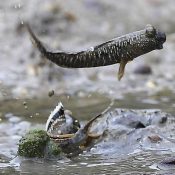
May 28, 2021 Ryukyu Shimpo
Among the mangroves of Sashiki Higata in Sashiki Fusozaki, Nanjo, Okinawa, the mating season of the barred mudskipper (tontonmi), which began at the start of spring, continues. On May 27, when a spring tide occurred, males could be seen engaging in courtship behavior, such as intimidating other males and leaping around to impress females.
On that day, the weather on the main island of Okinawa was cloudy with rain due to the influence of the baiu front. On Ishigaki Island and Miyako Island, an area of high atmospheric pressure meant blue skies. In Miyakojima City, temperatures in Kagamihara reached 33.2 degrees Celsius, while in Shimoji-shima, the temperature was 32.6 degrees. Both are the highest temperatures ever recorded in May for those areas. According to the Okinawa Meteorological Observatory, the baiu front will cause Okinawa to be cloudy with rain on May 28. Some areas are likely to have thunderstorms.
(English translation by T&CT and Ellen Huntley)
Go to Japanese
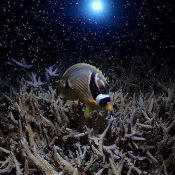
May 27, 2021 Ryukyu Shimpo
By Hideaki Yoneda
Coral spawning was observed on the night of May 26 at Aharen Beach in Tokashiki Village. Takashi Matsuda, 49, of the local diving shop Relax Island Tokashiki caught photographs of the spawning. There was a total lunar eclipse that day, and the super moon appeared very large on that evening in particular.
Photographs and videos: Scenes of the super moon in the sunset glow over Okinawa
Around 10:00 p.m., Matsuda, while surveying the spawning coral at Aharen Beach, confirmed large spawns from Acropora jacquelineae and Acropora muricata (staghorn coral).
Matsuda enthusiastically said: “I am deeply moved that this year we were able to see a total lunar eclipse of the super moon in conjunction with coral spawning on the same day. The mysteries of nature are enchanting.”
Coral only spawn once a year. Right around the night of the full moon in May or June when the spring tide comes in, coral gametes are released into the ocean and fertilization occurs.
(English translation by T&CT and Erin Jones)
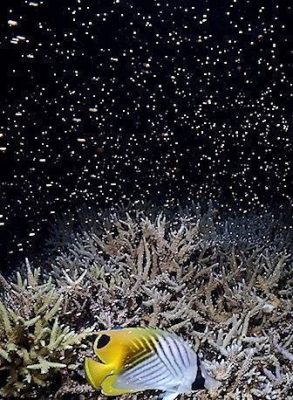
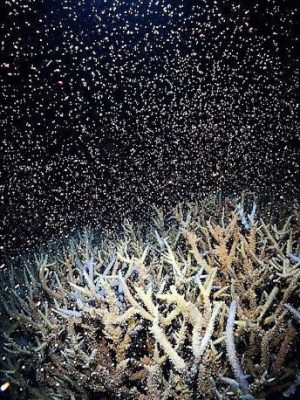
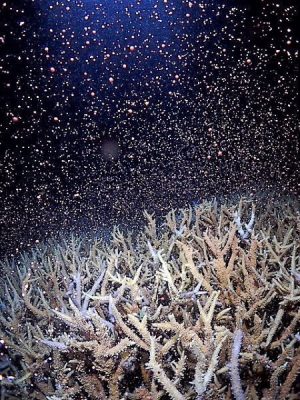
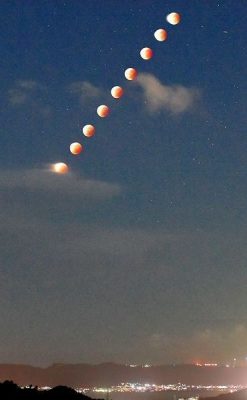
The progression of the total lunar eclipse shining red in the night sky. Photographed from 8:00 p.m. to 8:40 p.m. on May 26 from Haebaru Town in the direction of Nanjo City (composite of nine photographs)
Go to Japanese
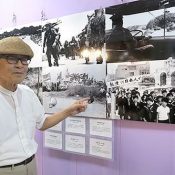
May 24, 2021 Ryukyu Shimpo
By Natsuko Yamakawa
(Tokyo) Journalist and former Ryukyu Shimpo reporter Katsu Moriguchi, age 83, of Chiba Prefecture, is holding a photography exhibit titled “Okinawa Under U.S. Rule: Memories of America-yu” at the Washita Shop in Ginza, Chuo Ward, Tokyo. The exhibit will be on display until May 31.
For more than half a century, since the 1950s, Moriguchi has reported on issues in Okinawa, and leads the “Okinawa wo kataru hitori no kai (one-person association for discussing Okinawa)”. The exhibit started on May 15, the anniversary of Okinawa’s return to Japan.
The exhibit includes 30 photographs, which include a photograph of children with carefree smiles taken in Itoman by Moriguchi at age 18, when he visited Okinawa in the spring of 1957, as well as photographs of a U.S. military tank driving imperiously down the winding roads of Nago (1960), Henoko/Kushibaru as the town scenery began to change after the U.S. military’s Camp Schwab and Camp Hansen were built (1957), priestesses of Kudakajima silently carrying out the August festival ceremony as U.S. military aircraft fly overhead (1963), and Self-Defense Force officer candidates standing on a stone gate of the Nakagusuku Castle ruins and studying the history of the Battle of Okinawa while looking at a strategy map for the Battle of Okinawa (1966).
“I thought that when Okinawa was returned, the bases would leave and it would become a peaceful island,” said Moriguchi. “The slogan was ‘kaku-nuki hondo-nami (free from nuclear weapons and equivalent to the mainland)’, but the U.S. military bases remained after reversion. In this exhibit, I presented just two photographs of the U.S. military after reversion. The burden of bases in Okinawa remains today no different from before reversion.”
(English translation by T&CT and Sandi Aritza)
Go to Japanese
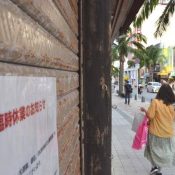
May 24, 2021 Ryukyu Shimpo
On May 23, the day Okinawa began a state of emergency that asked people stay home and businesses to close, the streets were much emptier than on a normal Sunday. Even there were some people out and about who grown weary of self-imposed isolation, business owners have seen customer foot traffic decline, and signs of exasperation over the strict business climate could also be seen. With places serving alcohol also closed, downtown nightlife is all but devoid of people.
In the afternoon of May 23, the souvenir stores that line Naha’s main street “Kokusai-dori,” people were sparse. Storefronts with their shutters closed stick out.
A sixty-year-old man facing his souvenir store, looked out at the sparsely populated street, lamenting “The street I see is a tough deal.” The storefront’s rent is around two million yen per month, but the days’ sales only reached around seventy-thousand. That is only about one-tenth of what they would see in pre-pandemic times. “Half of sales go to replenishing stock. Definitely not something can go on for very long. I wonder how long it will last? It is a problem of time,” he said with some resignation.
Financial aid has been made available for restaurants and major retailers, but there has been almost no assistance for souvenir stores. “It makes no difference if we close so we stay open, but no customers are coming. We are also in debt, so we can’t just get up and leave. I am envious of the restaurants have received aid. Who can we tell about the troubles of souvenir stores?”
A woman, 65, who works at another souvenir store said, “Today we had five, six customers. One of them encouraged us saying ‘We are coming back in August, so please don’t give up,’ which made me happy.” However, looking out over the empty store floor, her voice dropped, saying, “It must be tough for the owner.”
A woman who works at a produce store on Shijo Hon-dori said, “Since the state of emergency was announced, customers have fallen off sharply. Since fruit doesn’t keep very long, we keep having to lower the prices, but since no one is coming we can’t even sell it at a discount. Mangoes, pineapples, we end up having to just discard them. I wish that the politicians would come just once to see the state of affairs here. I expect they would feel something.” The tone was subdued, but there was a hint of anger as well.
Just after 8:30 p.m., even the restaurants in Naha that had not been adhering to the request to reduce business hours were closed. As the closing stores turn out their lights one after another, Kokusai-dori goes dark.
(English Translation by T&CT and Sam Grieb)
Go to Japanese
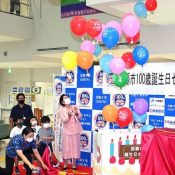
May 21, 2021 Ryukyu Shimpo
On May 20, Naha City celebrated its 100th anniversary as a city and held a centennial celebration at its city hall. The event commemorated the centennial anniversary as well as its history of overcoming tumultuous times, including the Battle of Okinawa and the reversion to Japan, and the city’s reconstruction and development since.
Naha City Mayor Mikiko Shiroma said, “The city’s development was made possible by our predecessors’ efforts, the residents’ yearning for peace, and our love for Naha. We will continue to give our best so that our children can smile brightly and everyone can live with a rich heart for the next 100 years.”
At the ceremony, Director of Japan Post Okinawa Branch Masatsugu Hisada presented a commemorative stamp to Mayor Shiroma. After the ceremony, a virtual exchange was held online to celebrate the 40th anniversary of Naha City’s sister city affiliation with Fuzhou, China.
Okinawa became a prefecture of Japan in 1879 with the Ryukyu Disposition, and Naha was designated the capital. Naha and Shuri became special wards in 1896, but compared to other Japanese prefectures, the operation of the local governance was ineffectual. In 1921, Okinawa adopted a city system similar to that of other prefectures. After WWII, Naha city merged with Shuri City and Oroku Village in 1954 and with Mahwashi City in 1957.
(English translation by T&CT and Monica Shingaki)
Go to Japanese















 Webcam(Kokusai Street)
Webcam(Kokusai Street)


